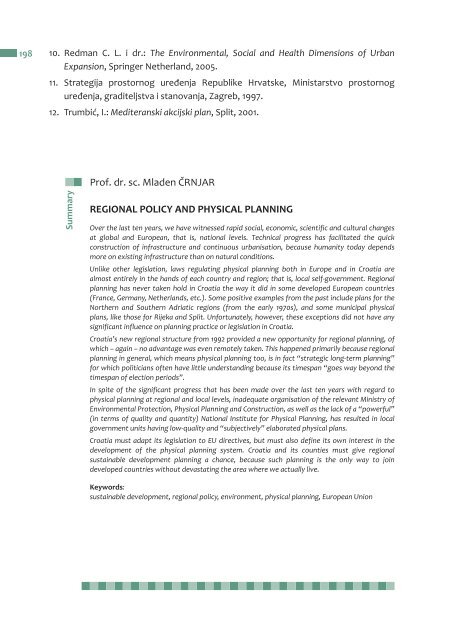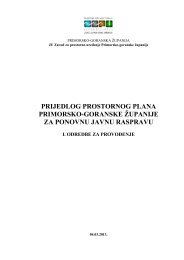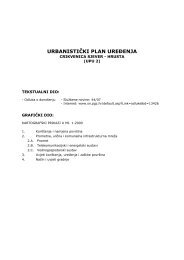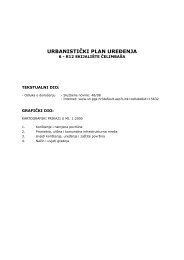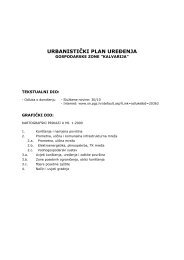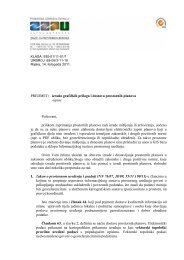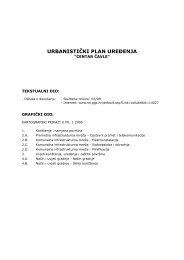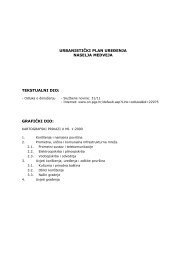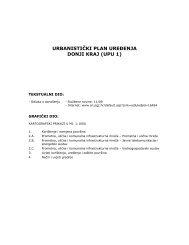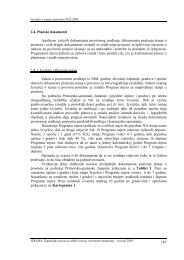- Page 4 and 5:
Primorsko-goranska županijaJavna u
- Page 6 and 7:
PREDGOVORIStrategija razvoja Primor
- Page 8 and 9:
KAZALO☐ PREDGOVORIZlatko Komadina
- Page 10 and 11:
JAVNA USTANOVA ZAVODZA PROSTORNO UR
- Page 12 and 13:
Javna ustanova Zavod za prostorno u
- Page 14 and 15:
Javna ustanova Zavod za prostorno u
- Page 16 and 17:
Prostorni plan Nacionalnog parka Ri
- Page 18 and 19:
Javna ustanova Zavod za prostorno u
- Page 20 and 21:
Javna ustanova Zavod za prostorno u
- Page 22 and 23:
Javna ustanova Zavod za prostorno u
- Page 24 and 25:
Javna ustanova Zavod za prostorno u
- Page 26 and 27:
Javna ustanova Zavod za prostorno u
- Page 28 and 29:
Javna ustanova Zavod za prostorno u
- Page 30:
OKRUGLI STOLPROSTORNO PLANIRANJE U
- Page 33 and 34:
32 1. UvodPrema popisu stanovništv
- Page 35 and 36:
34Slika 1. Mrkopalj, prijedlog regu
- Page 37 and 38:
36Slika 3. Tršće, Regulacijski pl
- Page 39 and 40:
38Slika 5. Lokve, Regulacijski plan
- Page 41 and 42:
40Slika 9. Podhum, Regulacijski pla
- Page 43 and 44:
42Slika 11. Jurčići-Kastav, prije
- Page 45 and 46:
44Dr. sc. Jasenka KRANJČEVIĆSumma
- Page 47 and 48:
46 1. UvodSudjelujući u izradi Koo
- Page 49 and 50:
48 Brodogradilište Beli kamik u Ri
- Page 51 and 52:
50 najsnažnije riječke industrije
- Page 53 and 54:
52☐ slaba mreža prometnica i pro
- Page 55 and 56:
54 tome poraditi i u što skorije v
- Page 57 and 58:
56 sustav, novi željeznički čvor
- Page 59 and 60:
58Draško BIŽACASummaryTHE ROLE OF
- Page 61 and 62:
60 1. UvodNakon utemeljenja Republi
- Page 63 and 64:
62 Djelovanje Odjela gradske uprave
- Page 65 and 66:
64 fakulteta u Zagrebu, 18 koji je
- Page 67 and 68:
66 U odnosu na strukturu građevins
- Page 69 and 70:
68 Torpeda, Sekundarni gradski cent
- Page 71 and 72:
70Grafički prikaz 2. Prostorna dis
- Page 73 and 74:
72Srđan ŠKUNCASummaryURBAN PLANNI
- Page 76 and 77:
Duško DOBRILAFUNKCIONIRANJE SUSTAV
- Page 78 and 79:
D. Dobrila • Funkcioniranje susta
- Page 80 and 81:
D. Dobrila • Funkcioniranje susta
- Page 82 and 83:
D. Dobrila • Funkcioniranje susta
- Page 84 and 85:
D. Dobrila • Funkcioniranje susta
- Page 86 and 87:
D. Dobrila • Funkcioniranje susta
- Page 88 and 89:
Prof. dr. sc. Nenad STARCDr. sc. Kr
- Page 90 and 91:
N. Starc - K. Črnjar • Prostorno
- Page 92 and 93:
N. Starc - K. Črnjar • Prostorno
- Page 94 and 95:
N. Starc - K. Črnjar • Prostorno
- Page 96 and 97:
N. Starc - K. Črnjar • Prostorno
- Page 98 and 99:
N. Starc - K. Črnjar • Prostorno
- Page 100 and 101:
N. Starc - K. Črnjar • Prostorno
- Page 102 and 103:
Korištene web straniceN. Starc - K
- Page 104 and 105:
Prof. dr. sc. Vidoje VUJIĆURAVNOTE
- Page 106 and 107:
V. Vujić • Uravnoteženo prostor
- Page 108 and 109:
V. Vujić • Uravnoteženo prostor
- Page 110 and 111:
V. Vujić • Uravnoteženo prostor
- Page 112 and 113:
Grafikon 1. Osnovna struktura građ
- Page 114 and 115:
V. Vujić • Uravnoteženo prostor
- Page 116 and 117:
V. Vujić • Uravnoteženo prostor
- Page 118 and 119:
V. Vujić • Uravnoteženo prostor
- Page 120 and 121:
V. Vujić • Uravnoteženo prostor
- Page 122 and 123:
Prof. dr. sc. Čedomir DUNDOVIĆNev
- Page 124 and 125:
Č. Dundović - N. Grubišić • R
- Page 126 and 127:
Č. Dundović - N. Grubišić • R
- Page 128 and 129:
Č. Dundović - N. Grubišić • R
- Page 130 and 131:
Č. Dundović - N. Grubišić • R
- Page 132 and 133:
Č. Dundović - N. Grubišić • R
- Page 134 and 135:
Č. Dundović - N. Grubišić • R
- Page 136 and 137:
Prof. dr. sc. Dora SMOLČIĆ JURDAN
- Page 138 and 139:
Grafikon 1. Sezonalnost turističko
- Page 140 and 141:
D. Smolčić Jurdana • Razvoj tur
- Page 142 and 143:
D. Smolčić Jurdana • Razvoj tur
- Page 144 and 145:
D. Smolčić Jurdana • Razvoj tur
- Page 146 and 147:
D. Smolčić Jurdana • Razvoj tur
- Page 148 and 149: D. Smolčić Jurdana • Razvoj tur
- Page 150 and 151: D. Smolčić Jurdana • Razvoj tur
- Page 152 and 153: Dr. sc. Ljudevit KRPANZNAČENJE PRO
- Page 154 and 155: Lj. Krpan • Značenje prometne in
- Page 156 and 157: Lj. Krpan • Značenje prometne in
- Page 158 and 159: Shema 2. Izazovi urbanog prometaIzv
- Page 160 and 161: Shema 3. Ponuda i potražnja kao el
- Page 162 and 163: Lj. Krpan • Značenje prometne in
- Page 164 and 165: Lj. Krpan • Značenje prometne in
- Page 166 and 167: Dr. sc. Koraljka VAHTAR-JURKOVIĆPR
- Page 168 and 169: K. Vahtar-Jurković • Primjena no
- Page 170 and 171: K. Vahtar-Jurković • Primjena no
- Page 172 and 173: K. Vahtar-Jurković • Primjena no
- Page 174 and 175: K. Vahtar-Jurković • Primjena no
- Page 176 and 177: Prof. dr. sc. Aleksandra DELUKA-TIB
- Page 178 and 179: Shema 1. Struktura studija na Građ
- Page 180 and 181: A. Deluka-Tibljaš • Doprinos Gra
- Page 182 and 183: Shema 2. Organizacija modula na sve
- Page 184 and 185: A. Deluka-Tibljaš • Doprinos Gra
- Page 186 and 187: A. Deluka-Tibljaš • Doprinos Gra
- Page 188 and 189: A. Deluka-Tibljaš • Doprinos Gra
- Page 190 and 191: Prof. dr. sc. Mladen ČRNJARREGIONA
- Page 192 and 193: M. Črnjar • Regionalna politika
- Page 194 and 195: M. Črnjar • Regionalna politika
- Page 196 and 197: M. Črnjar • Regionalna politika
- Page 200 and 201: Mr. sc. Hrvoje MARUŠIĆEUROREGIJE
- Page 202 and 203: H. Marušić • Euroregije i uprav
- Page 204 and 205: H. Marušić • Euroregije i uprav
- Page 206 and 207: H. Marušić • Euroregije i uprav
- Page 208 and 209: H. Marušić • Euroregije i uprav
- Page 210 and 211: Adam BUTIGANIZGRADNJA INFORMACIJSKO
- Page 212 and 213: A. Butigan • Izgradnja Informacij
- Page 214 and 215: A. Butigan • Izgradnja Informacij
- Page 216 and 217: A. Butigan • Izgradnja Informacij
- Page 218 and 219: A. Butigan • Izgradnja Informacij
- Page 220 and 221: Shema 1. Integracija dva postojeća
- Page 222 and 223: A. Butigan • Izgradnja Informacij
- Page 224 and 225: Dr. sc. Mirjana BABIĆODNOSI S JAVN
- Page 226 and 227: Shema 1. Stručni tim za izradu pro
- Page 228 and 229: M. Babić • Odnosi s javnošću u
- Page 230 and 231: Shema 2. Proces kreiranja cyber rep
- Page 232 and 233: M. Babić • Odnosi s javnošću u
- Page 234 and 235: M. Babić • Odnosi s javnošću u
- Page 236 and 237: M. Babić • Odnosi s javnošću u
- Page 238 and 239: Zoran SKALAPRILAGODBE NA VANJSKAOGR
- Page 240 and 241: Z. Skala • Prilagodbe na vanjska
- Page 242 and 243: Z. Skala • Prilagodbe na vanjska
- Page 244 and 245: Z. Skala • Prilagodbe na vanjska
- Page 246 and 247: Z. Skala • Prilagodbe na vanjska
- Page 248 and 249:
Z. Skala • Prilagodbe na vanjska
- Page 250 and 251:
OSOBNA KARTA ZAVODAJavna ustanova Z
- Page 252 and 253:
Organizacijska shema Javne ustanove
- Page 254 and 255:
253
- Page 256:
Ksenija KOMLJENOVIĆ, dipl. ing. ar
- Page 259 and 260:
258 1990. PUP gradskog naselja Krnj


